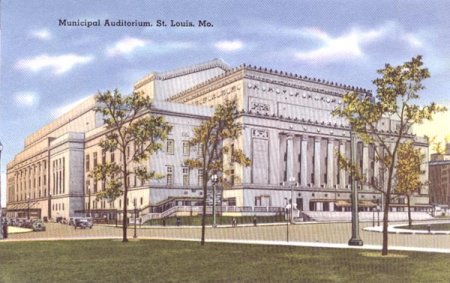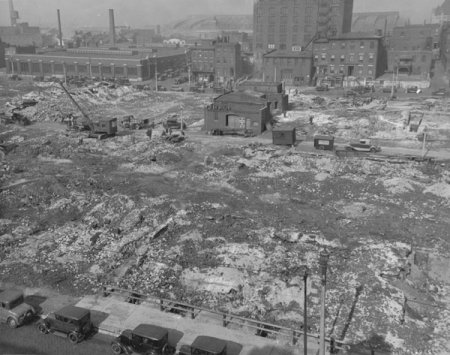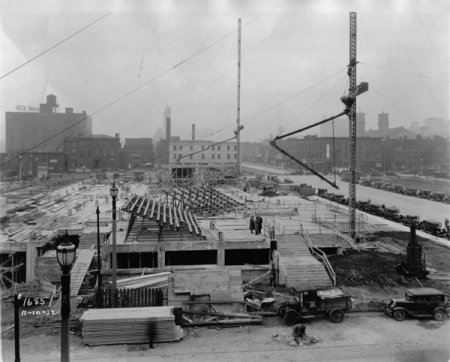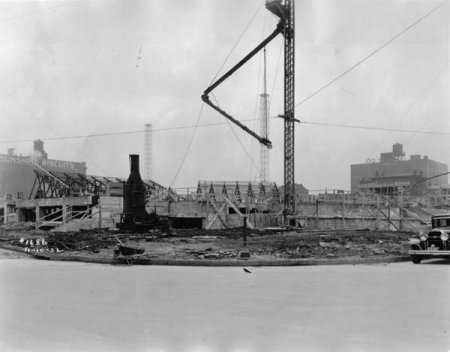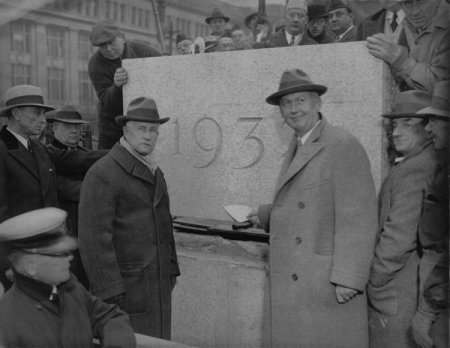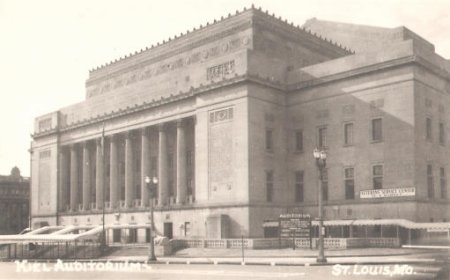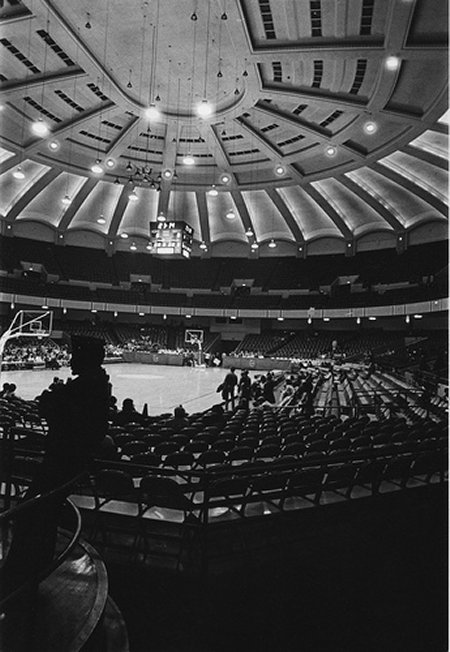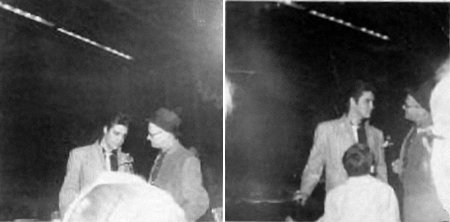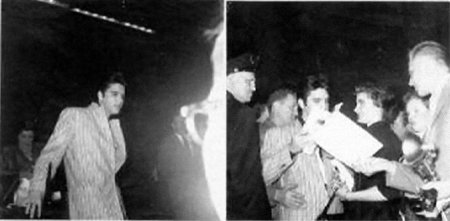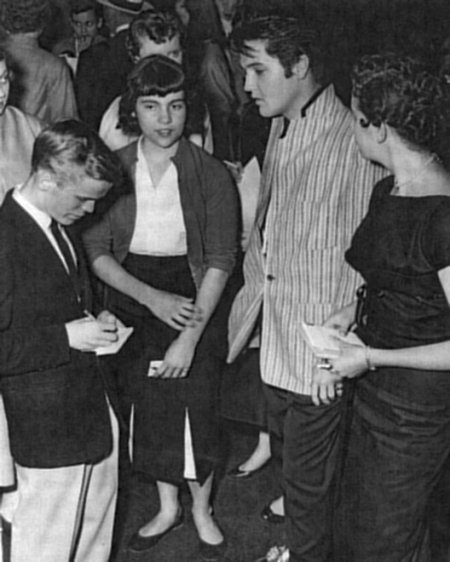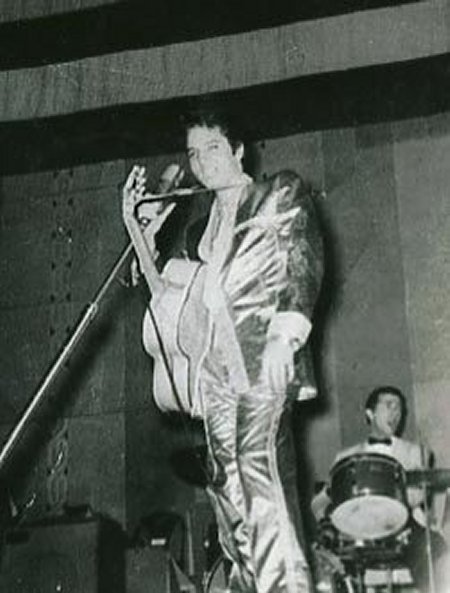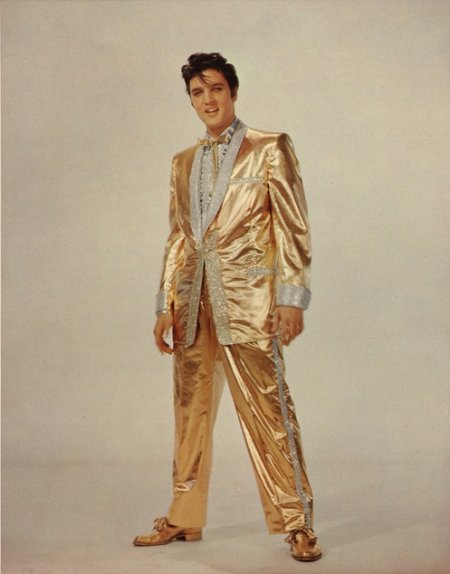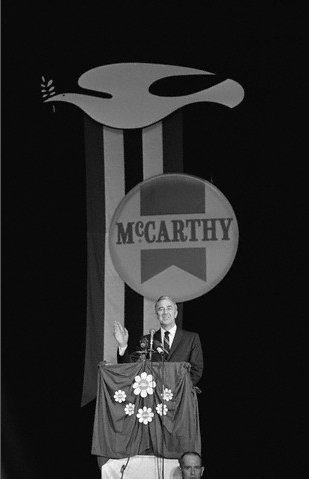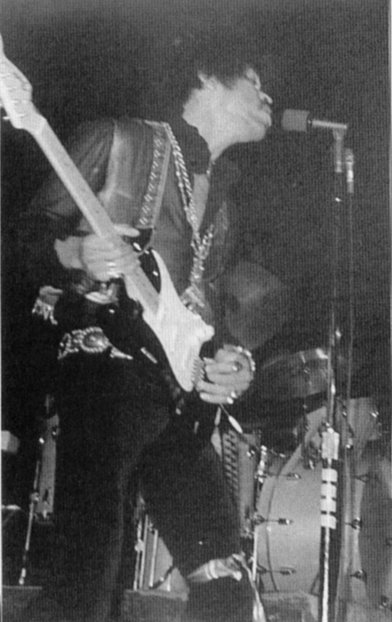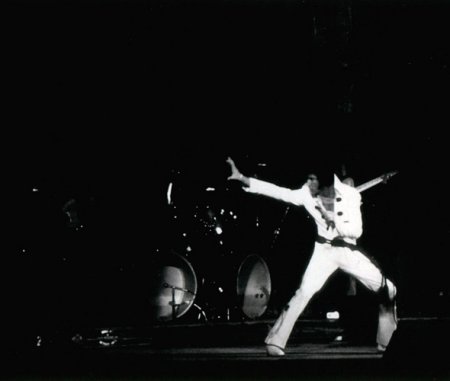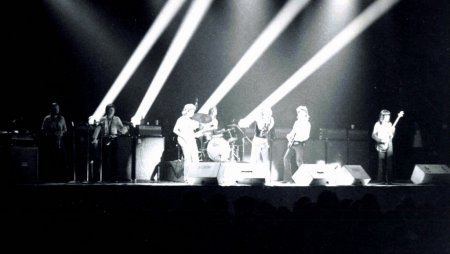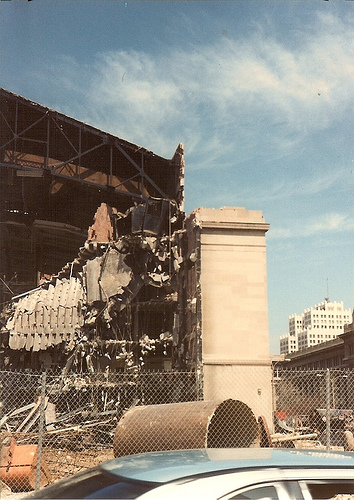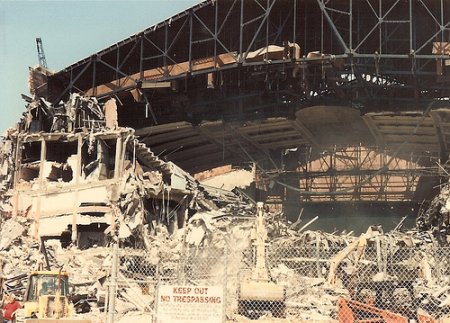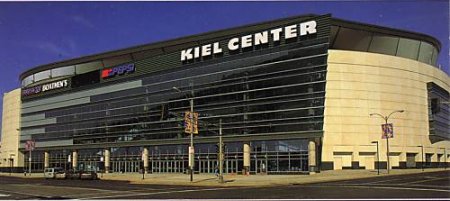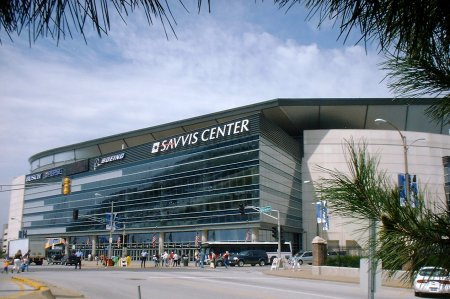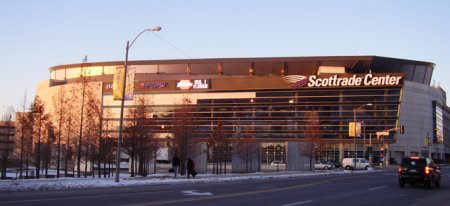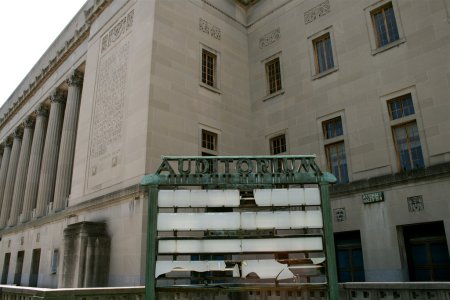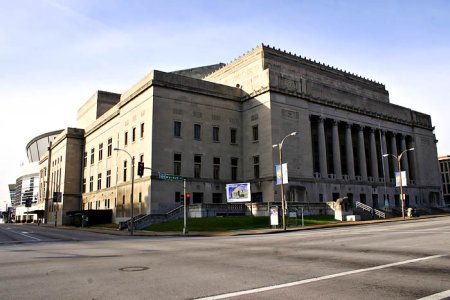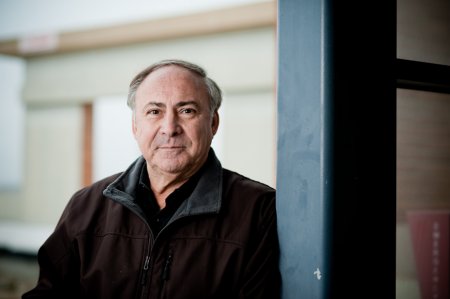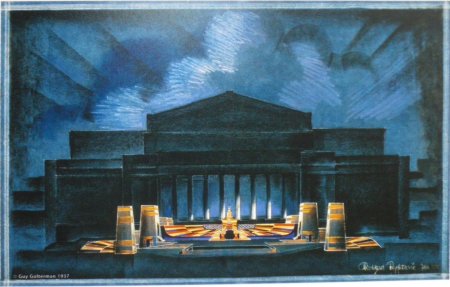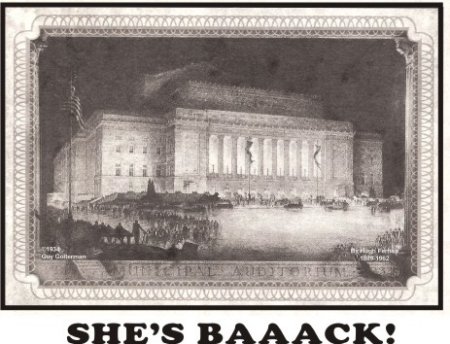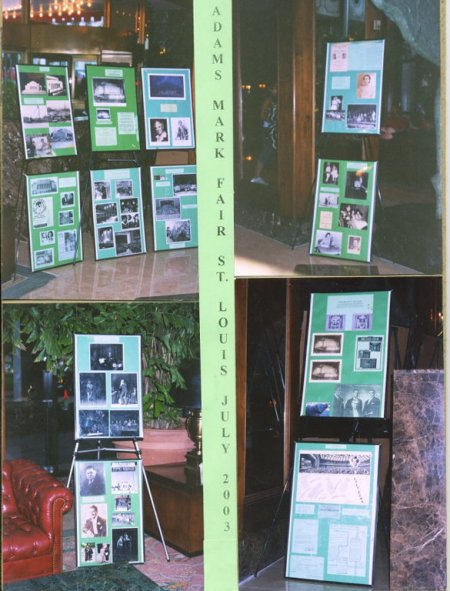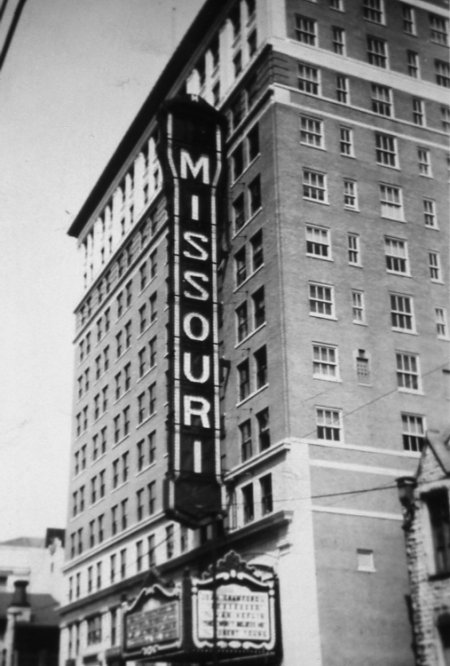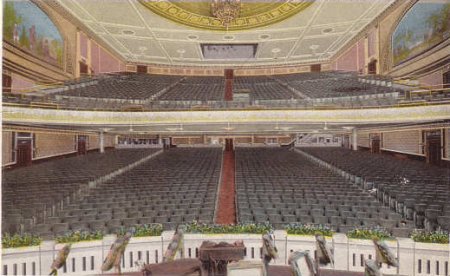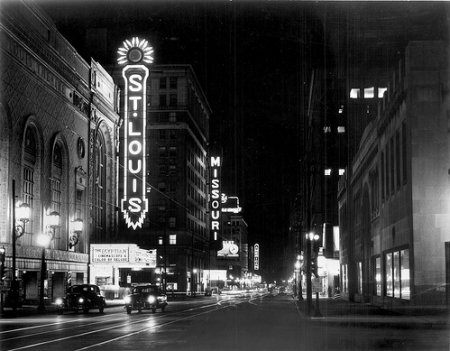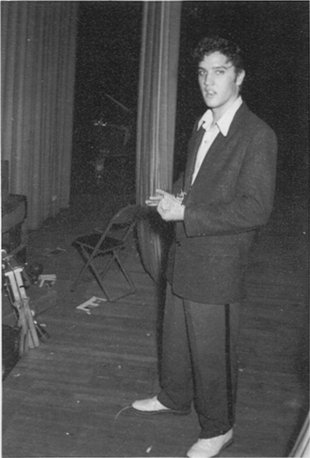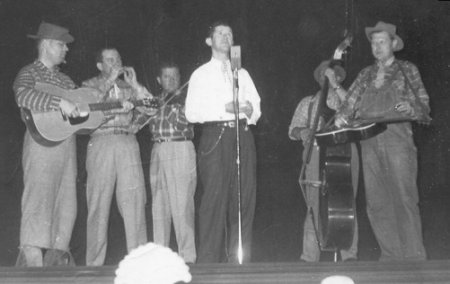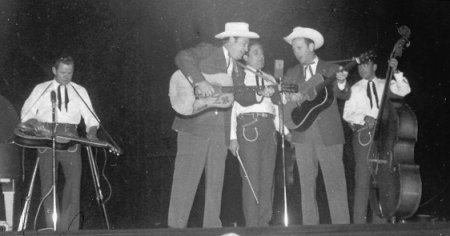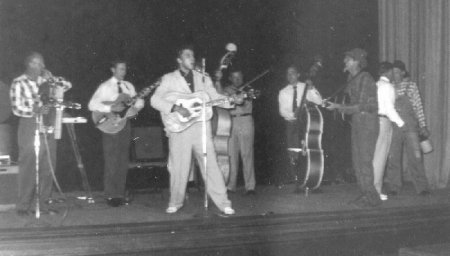 |
Kiel Municipal Auditorium
Building for the Municipal Auditorium and Opera House in St. Louis, Missouri was begun in 1932. Designed by St. Louis architects Louis LaBeaume and Eugene S. Klein, it served St. Louis for six decades as a center for conventions, public meetings, expositions, sports events and musical performances.1
After two city blocks bounded by Market, 14th, Clark and 15th had been cleared, work started on the foundation for the new Municipal Auditorium and Opera House.2
The building was completed in 1934, and originally contained an auditorium back-to-back with the Opera House. The huge, limestone-clad building features a row of massive, multi-story columns facing Market Street, as well as numerous Beaux Arts details.3
According to a 1934 mayoral proclamation, the Auditorium was "designed to enrich the peoples' lives and increase their enjoyment and...add to the attractiveness and popularity of our City as it will bring to us great conventions and cultural activities."1
Originally known as the Municipal Auditorium, Kiel Auditorium was officially named in honor of former St. Louis mayor Henry W. Kiel on March 26, 1943. Kiel, a strong supporter of the arts, had encouraged the idea of a municipal auditorium and helped that concept become a reality.1
During its early years, Kiel Auditorium hosted such varied events as the Grand Opera presentation of "La Boheme," starring the famous soprano Lucrezia Bori, the first National Folk Festival, and a two-week-long exposition of St. Louis business and products called "St. Louis on Parade." Later, the facility continued its tradition of diversity by hosting events ranging from the Ziegfield Follies, the Grand Ole Opry and the Metropolitan Opera to roller derby competitions, wrestling, and Broadway productions of "Annie," "A Chorus Line," "Evita" and "My Fair Lady." 1
In addition to serving as the primary venue for the St. Louis Symphony Orchestra, the St. Louis Philharmonic Orchestra, Dance St. Louis and St. Louis' annual Veiled Prophet Ball, Kiel Auditorium served as the home court of the St. Louis Hawks professional basketball team and the Saint Louis University Billikens basketball team.1
On New Years day, January 1, 1956, Elvis, Scotty, Bill and DJ performed for the first time at Kiel Auditorium. Though it was their first appearance at Kiel, it was the second trip to perform in St. Louis for Elvis, Scotty and Bill, having performed two dates the previous October at the Missouri Theater on a bill with Roy Acuff and Kitty Wells. For the January appearance they shared the bill with Hank Snow, Slim Whitman, Webb Pierce, Benny Martin, comedian/singers Rod Brasfield, Whitey Ford (the Duke of Paducah) and Dr. Lew Childre. Their next appearance at Kiel was just over a year later, on March 29, 1957. By now Elvis had made all the television appearances he would make until after his discharge from the Army. His first movie, Love Me Tender, had been released the November before and he had completed production of his second, Loving You, earlier that month. The St. Louis date was the second stop of their first tour that year that had started in Chicago the day before where he debuted the Gold Lame' suit custom tailored for him by Nudie Cohen of Hollywood.
The review in the St. Louis Dispatch the following day read, Elvis Presley, shimmering in sequins and metallic gold cloth, writhed and sang last night in Kiel Auditorium convention hall before a capacity crowd of about 11,000 spectators, most of them teen-age girls. Many times the appreciative audience drowned out Presley. The performer, who had secluded himself in a Hotel Chase room all day under an assumed name, had been spirited by police into the auditorium by an obscure alley entrance to avoid admirers standing guard at the stage door.4
He had been escorted to the hall in time to avoid the Market street traffic snarl caused by his scheduled appearance. Shortly before 8 p.m. curtain time, eastbound machines were inching along from a point west of Union Station.
After the intermission, during which spectators had another chance to buy Elvis Presley souvenirs, the 22-year-old performed bounded onto the stage and the uproar began. He glittered and grimaced. Rhinestones embedded even in the laces of his gold colored, raised heel shoes added to the dazzling sight.
Musicians from a jazz concert playing to a small audience in the auditorium's adjoining opera house sneaked into the wings to watch Presley perform.
"Man, how much do you suppose those yard goods cost him?' one of them speculated.
During the earlier press conference, in response to directions by photographers, he dutifully kissed girls on the cheek, and posed with them, clasping one on either side by the waist. He quickly disengaged himself, not with impolite haste, after each photograph. Following St. Louis, the tour went on to Indiana, Detroit, Buffalo, Toronto and Ottawa before ending in Philadelphia on April 6th.
On August 14, 1968 Senator Eugene McCarthy met with Missouri's delegates to the Democratic Convention and spoke to a crowd of 14,000 at Keil Auditorium. With a symbolic dove of peace with draped red, white, and blue bunting in the background on the stage, his biggest ovation during the speech came when he said "the pursuit of this (Vietnam) war can no longer be justified on political or economic grounds -- or on moral grounds."
In 1992, St. Louis city officials recognized the size inadequacy of the 9,000-seat Auditorium as well as the need for a new, state-of-the-art arena.1
The auditorium portion was torn down in to make way for the multipurpose Kiel Center, which was opened in 1994. In August 2000, naming rights for the building were sold to SAVVIS Communications Corporation. In 2006, naming rights for the building were sold to Scottrade, a St. Louis-based leading branch-supported online brokerage. The building is now known as Scottrade Center.1
Scottrade Center is now the home of the St. Louis Blues Hockey Club. Scottrade Center also features a full range of arena programming, including concerts, ice shows, family shows and other sporting events. Scottrade Center plays host to approximately 175 events per year, bringing nearly 2 million guests to downtown St. Louis annually and ranking it as one of the top arenas in the country.1
The last event held in the Opera House was in 1991. As part of the deal that allowed them to tear down the auditorium, the Kiel Center Partners (now known as Clark Enterprises) was supposed to renovate the Opera House. Having repaired the roof and stabilized the the building, KCP claimed it has fulfilled its financial obligation to the project but the building remained shuttered. In 1998, a fact-finding panel investigated the building and concluded that it was structurally sound.3
In April of 2009 it was announced that there were plans to reopen the Opera House and that a $40 - $60 million renovation was underway with hopes to be reopened by December 2010 (video).5 In May the St. Louis Board of Aldermen approved a $74 million package to finance the reopening of the Kiel and by October, the St. Louis Dispatch that the project was on schedule and that David Urban, the General Manager of the New York's Radio City Music Hall during its renovations had been placed in charge to make it happen again.6
page added November 11, 2009
All ads are courtesy Lee Cotten's "Did Elvis Sing in
Your Hometown?" The photo of Elvis at Kiel in September of 1970 by
Dagmar was used here with her permission. Check out her photo book
"ELVIS! By Dagmar" and a sampling of her R'nR photos at www.dagmarphoto.com.
Hello,
I am Ed Golterman, my grandfather was Guy Golterman the grand opera producer who's Aida opened at the Kiel opera house on April 21st in 1934. He presented several seasons in the opera house and a couple in the convention hall. The Golterman grand opera set four world or U.S. attendance records - in St. Louis and Cleveland.
In 1998 I began efforts toward the restoration and reopening of Kiel Opera House. I found many hard battles, and with others helped save it from several gutting attempts and worked months to obtain a grant to get it on the National Register of Historic Places. It was placed on the Register in February of 2000 which made it a viable business venture to restore.
In 2008, I published 'The Mugging of Kiel Opera House' which began with what the aerial photos on your site show. They've cut into the opera house at an angle destroying dozens of dressing rooms. Over the years the hockey side commandeered more space, and it looked like they were never going to reopen it. With the reopening of the opera house last year a 13-year journey ended.
Since 1998 I've traveled with an exhibition entitled "From Kiel to Peabody," an hour lecture/discussion with a 50 panel historic exhibit covering its 6 decades which presents many positive messages. I also have three large historic anthologies: The National Folk Festival; The opera careers of Maria Marceno which cover grand opera from the beginning; and 200 letters from 98-to present.
Perhaps a thousand items in all. I don't charge admission or sell a product and like your site it is more about education and promoting preservation. Currently I do about a presentation a week and would like to do more and in time hope to find a permanent location for his huge exhibit. Ed
Golterman, February 1, 2012
Missouri Theater
The Missouri Theatre was one of the most popular theatres in St. Louis in the 1920's. Built in 1921, it was located at Grand and Lucas and housed inside the twelve story brick Missouri Theatre Building, but distinguished by a light stone front. It had a seating capacity of 3558 and was one of the largest theatres in the nation at that time. It was designed by the firm of DeRosa & Pereira for the Famous Players Missouri circuit, which was a subsidiary of the Famous Players Lasky circuit.1
Luxury abounded, rotundas with massive chairs, fireplaces in many rooms and three inch thick carpeting added to the already impressive decor. The interior featured arches and Corinthian columns. Curved architecture throughout the theatre gave the impression of softness in contrast to modern streamlined architecture.1
The Missouri Theatre was one of the first theatres in St. Louis to have
air conditioning, which was a big deal then. It was called "the
Pike's Peak Breeze" in it's advertising of the air conditioning.
The theatre was later operated by Skouras Bros., RKO, and Fanchon &
Marco which evolved into Arthur Enterprises. The Missouri was so
successful that the Skouras Brothers went on to build a sister theatre
only a block away, the St. Louis Theatre (now Powell
Symphony Hall).1
On October 21, 1955, Elvis, Scotty and Bill made their first appearances in St. Louis when they rejoined a tour with Roy Acuff and Kitty Wells for three days of performing at the Missouri Theater. They had performed with them days earlier at the Circle theater in Cleveland and briefly left the tour for appearances at the Brooklyn High School and St. Michael's Hall to participate in Bill Randle's documentary.
According to Elvis Day by Day, Elvis was scheduled to open the 2:00 p.m. show on Sunday, the 23rd, but arrived late, saying that he was searching for his wallet. As a result of his tardiness, he was not permitted to perform and, with the Colonel's approval, docked $125 pay.2
The Missouri Theatre was last used in December, 1957, abandoned then razed for a parking lot on June 26, 1959.1 added November 11, 2009
October 20, 1955 advertisement from the St. Louis
Dispatch is courtesy Trent Sindelar, Information Services at St. Louis Public Library. 1
excerpts from Missouri
Theater by by Charles Van Bibber, JAlex, Paul Knittel courtesy Cinema
Treasures
|
|
All photos on this site (that we didn't borrow) unless otherwise indicated are the property of either Scotty Moore or James V. Roy and unauthorized use or reproduction is prohibited. |
